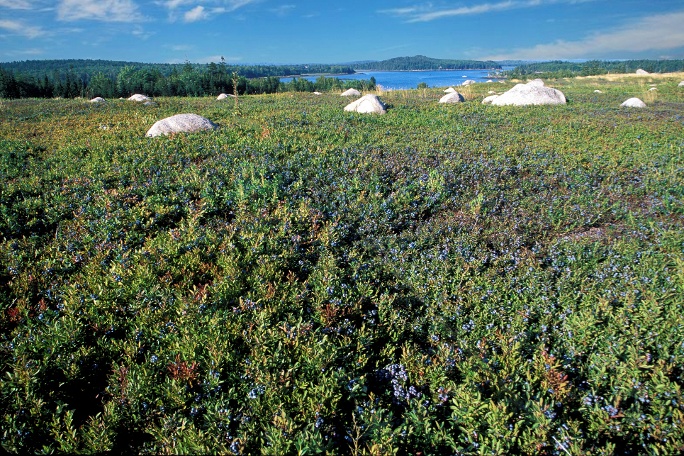Did you know there are two types of blueberries?
One is smaller, higher in antioxidants, and beloved bby food service chefs & kids.
Fruit is fruit and berries are berries, right? Well, no, there is a big difference between the fruits and the berries we buy and eat. And the difference starts right in the fields where they grow.
If you happen to be lucky enough to visit a Wild Blueberry barren, you will experience one of nature’s great miracles. Tens of thousands of acres unfurl across a barren landscape, populated by an unassuming, but resilient, low-bush shrub. These deciduous little plants literally cling to the ground year-round, through the harshest of conditions, producing billions of tiny, sweet flavor bursts, known as Wild Blueberries.

If it’s May, the fields will be a buzz with honeybees, pollinating each blossom. If it’s August, the plants will be bursting with fruit. If it’s September, the fields with be ablaze in vibrant red. If it’s winter, well, in winter you might want to be in Florida.
Amazingly, this annual cycle of life has been taking place for 10,000+ years in only one special place on earth. You see, Wild Blueberries (Vaccinium angustifolium) are indigenous plants. They occur naturally on “the barrens” of Maine and Eastern Canada, and they are commercially grown in no other place in North America (except for some small farms in New Hampshire and Massachusetts). The local Wabanaki tribes were among the first humans to use Wild Blueberries for their flavor, nutrition, preservative, and healing qualities. While so many of the foods in today’s diet have been manipulated for taste, size, and extended shelf-life, Wild Blueberries have remained unchanged…. for millennia.
[blog_cta post_id=”16166″]
Ask any child (or millennial, for that matter), and they’ll tell you what’s so great about eating Wild Blueberries. Their answers usually start with taste. But there are plenty more reasons to love – and respect – the humble Wild Blueberry.
Here are 10 top reasons to love Wild Blueberries.
- Wild Blueberries are not planted! The plants establish by themselves and survive in the glacial soils of Maine and Eastern Canada. Larger cultivated blueberries come from several highbush varieties that are bred, planted, and harvested around the world.
- Wild Blueberries are diverse. In fact, a single Wild Blueberry field hosts thousands of varieties of dark and light berries. This diversity is what gives Wild Blueberries their complex and delicious flavor. Compare this to cultivated blueberries, which might host only a half-dozen varieties in one growing area.
- Wild Blueberries have twice the antioxidant capacity of cultivated blueberries. Diets rich in antioxidants are associated with reduced risk of chronic diseases.
- Wild Blueberries have a higher skin-to-pulp ratio than cultivated blueberries. More skin and less water equals more intense blueberry flavor, more antioxidant-rich pigment, and 72% more fiber. Less water also means that Wild Blueberries stand up to the rigors of cooking and baking better than cultivated blueberries.
- Wild Blueberries have less sugar than cultivated blueberries. In fact, one cup of Wild Blueberries contains only 10 grams of sugar vs 15 grams per cup in cultivated blueberries.
- Wild Blueberries are frozen. In fact, 99 percent of the Wild Blueberry crop is frozen at its peak of ripeness, locking in each berry’s nutrition and great taste. This flavor and nutrition advantage makes them a favorite of school food service chefs.
- New USDA yield data recently revealed that one pound of frozen Wild Blueberries provides 25% more servings than the same weight of frozen cultivated blueberries. This spells lower cost per serving for school food service.
- Wild Blueberries give you more than twice the number of berries per pound than cultivated blueberries, which means your baked goods have more berries in every bite. This is another reason why chefs simply love them.
- Wild Blueberries are purple. The vibrant purple color of Wild Blueberries translates into higher levels of anthocyanins, an anti-inflammatory flavonoid that has a long and growing list of health benefits.
- Finally, two British studies recently revealed that consuming wild blueberries may have positive effects on young people. One study showed that when children consume wild blueberries they show greater memory and better concentration. A second study shows that Wild Blueberries may significantly boost mood in young adults and children. The second study is unique among the growing body of research exploring the association between nutrition and mental health.
So, the next time you’re dreaming up a sure-fire, kid-friendly smoothie, parfait, salad dressing, or fruit cup, consider putting a heaping amount of nature’s tiny miracles inside. For more recipes, click here.


